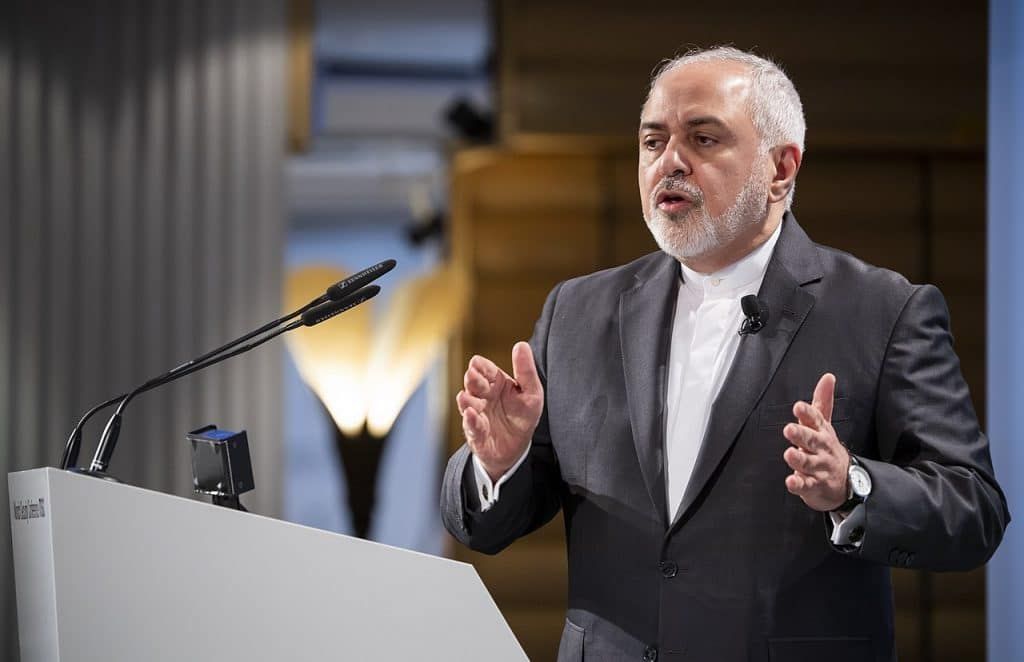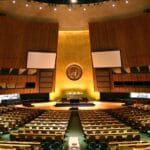“Transactional” nuclear diplomacy may provide a path toward “grand bargains” with Iran and North Korea
By Christopher Lawrence | April 29, 2021
 Iran’s Foreign Minister Mohammad Javad Zarif, in 2019. Zarif will play an important role in talks on whether Iran and the United States will fully re-enter the Joint Comprehensive Plan of Action.
Iran’s Foreign Minister Mohammad Javad Zarif, in 2019. Zarif will play an important role in talks on whether Iran and the United States will fully re-enter the Joint Comprehensive Plan of Action.
As the Biden Administration re-engages Iran and reviews US policy toward North Korea, analysts are debating whether a “transactional” approach that focuses on reducing the nuclear threat is sufficient, or whether the U.S. should seek a transformative “grand bargain” that addresses other “malign behaviors.” Proponents of “transactional” diplomacy argue that comprehensive deals to transform political relationships are unrealistic, and that zeroing in on the most pressing issue is the only way to make any tangible progress. The “grand bargainers” retort that any deal that isn’t comprehensive will face fatal opposition from important stakeholders.
Both arguments have some merit, but the perceived distinction between them is a false one: Past engagements with Iran and North Korea were premised on the hope that piecemeal transactions could provide a platform for more sweeping diplomacy. And the best nonproliferation progress has been achieved when all sides perceived diplomatic transactions as incremental steps toward broader reconciliation.
America made its first bet that transactional nonproliferation diplomacy could pave the way for broader engagement almost two decades ago, when it signed the 1994 Agreed Framework with North Korea. It was clear to US diplomats at the time that denuclearization and transformation of the US-North Korean relationship would be a package deal, because North Korea would lack incentive to fully disarm if that relationship remained hostile. Yet, at first glance, the framework looks like a quintessential nuclear transaction – the North agreed to dismantle its plutonium reactors in exchange for civilian power reactors from the West. While the text of the agreement calls for both sides to “move toward full normalization of economic and political relations,” its vagueness on how to implement that goal meant that it was essentially postponed for later negotiations to flesh out. But if we hold that stated political goal in our minds, and alongside it analyze the physical task of building and operating large Western power reactors in North Korea, it becomes clear that the political effects of those reactors would extend far beyond the nuclear realm.
Since nuclear energy is one of the most globalized technologies in existence, North Korea would inevitably be drawn into the international networks of technical collaboration that make the construction and operation of Western power reactors possible. And as my research on the negotiating history of the Agreed Framework shows, this sort of technological entanglement was precisely the point: A major civilian reactor project could serve as the physical embodiment of the political changes that otherwise seemed impossible. It could thereby pave the way for more explicit political changes down the road.
The real question, however, is whether this scheme showed any signs of working. After all, didn’t the Agreed Framework fail to disarm North Korea? Here again, a more nuanced look at the historical facts tells a different story.
On the nonproliferation front, the framework has been the most successful U.S. policy to date at physically rolling back North Korea’s nuclear weapons capability. Most of the first civilian reactor was built in North Korea, and the construction progress served as a barometer through which the North Korean regime could gauge US commitment to eventual normalization. Sure enough, when construction of the reactors fell behind, the regime slowed its disarmament progress and hedged its bets by obtaining uranium centrifuges on the black market. But when construction progress picked back up in 1999, nuclear rollback resumed, and progress on implementation cleared the way for substantive diplomatic progress on several other fronts.
By the time US Secretary of State Madeleine Albright met with Kim Jong-Il in the fall of 2000, the North Korean leader was ready to propose a point-by-point plan to completely end North Korea’s missile program. In other words, the Agreed Framework made significant progress both at rolling back North Korea’s nuclear program and at facilitating concessions in other areas, and the pace of this progress was correlated with the fits and starts of the civilian reactor project. Unfortunately, the framework ultimately collapsed in 2002, after a new US administration that was hostile to the deal entered office.
Does that sound familiar?
Today the United States is at a similar crossroads with Iran. The Joint Comprehensive Plan of Action (JCPOA) was premised on the bet that transactional diplomacy could incrementally transform Iran’s political relationships with the West. Implementation of the deal unequivocally reduced the risk posed by Iran’s nuclear program, and this success was demonstrated by a string of consecutive reports by the International Atomic Energy Agency (IAEA). Beyond the nuclear issue, several aspects of Iran’s “malign behavior” appear to correlate with US adherence to the agreement. Iran’s provocations in the region, while not ceasing completely, were considerably diminished while the deal was in force. But as the Trump administration progressively reneged, Iran attacked US bases and allies in the region and showed that it can effectively sabotage Saudi Arabia’s oil production. So just as in the Agreed Framework case, effective implementation of a bounded nuclear deal has implications far outside the nuclear realm.
But the JCPOA’s connection between transaction and transformation runs deeper than simple correlations. After four decades of economic and political estrangement, sanctions and latent nuclear proliferation have become the defining elements of Iran’s relationship with the West. This estrangement is physically manifest in a lack of foreign direct investment in Iran. In sectors ranging from oil and gas to air and ground transportation, Iranian infrastructure is distinguished by its absence of Western collaboration and shared investment. Thus, effective implementation of the JCPoA – continuing to address the nuclear issue and bringing Western investment into Iran’s infrastructure where it does not now exist – could transform the very physicality of that political relationship. And the shared interests that would be embodied in those new infrastructures could then create new incentives for both sides to engage in further reconciliations, such as reducing Iran’s reliance on ballistic missiles.
Similar opportunities have arisen on the Korean Peninsula. While Western pundits were focused on President Trump’s high-profile summits with North Korean leader Kim Jong-un, South Korean President Moon Jae-in proposed a series of development projects that, if carried out, would fundamentally change North Korea’s relationship with the outside world. If incremental North Korean nuclear rollback steps were coordinated with sanctions waivers to allow some of these projects to proceed, it may be possible to slowly alter North Korea’s political relationships in ways that reduce its reliance on nuclear weapons. This may have been the logic behind North Korea’s offer in 2019 to dismantle its most important nuclear facilities in exchange for partial sanctions relief. Yet the Trump Administration foolishly stuck to its all-or-nothing approach – grand bargain or maximum pressure. He thus missed a golden opportunity to design a partial nonproliferation deal that could pave the way for more a comprehensive solution.
A new administration should not make the same mistakes that Trump made. It should creatively engineer – and faithfully implement – incremental transactions that not only reduce security risks in the near term, but also pave the way for broader diplomatic solutions down the road. Transactional steps toward political transformation with Iran and North Korea will indeed constitute a “bet” – there is no guarantee that these more benign shared incentives, if created by carefully engineered transactions, will prevail. And just as with the Agreed Framework, the physical and financial challenges of implementing the JCPOA, or a new deal with North Korea, will make the road to reconciliation uneven and contingent on the political will of successive presidential administrations.
But each step that is taken down that road can reduce near-term security risks and make the subsequent steps toward reconciliation more realistic. Rather than choose between “kick-the-can” transactions and unrealistic transformations, the United States should begin building the foundations of reconciliation with Iran and North Korea so each phase of diplomacy brings us closer to more enduring solutions.
Together, we make the world safer.
The Bulletin elevates expert voices above the noise. But as an independent nonprofit organization, our operations depend on the support of readers like you. Help us continue to deliver quality journalism that holds leaders accountable. Your support of our work at any level is important. In return, we promise our coverage will be understandable, influential, vigilant, solution-oriented, and fair-minded. Together we can make a difference.
Keywords: Iran, North Korea, grand bargain, transactional diplomacy
Topics: Nuclear Weapons
















It might be the real solution is to ban nuclear weapons outright, rather than prevent the proliferation of them. If everyone can have the latest ‘toy’ it may may push for a total ban. Politically, I don’t think this will ever happen.
Probably the best articulation I have seen of why re-entering the JCPoA makes sense for the U.S. As you have said separately, a physical investment/entwining of the U.S. in North Korea is what they really wanted for their security. The same can perhaps be said of Iran and the West.
Tackling Iran and the DPRK’s nuclear destructive capabilities is fine. But what about Israel’s? Or is it a no-no?